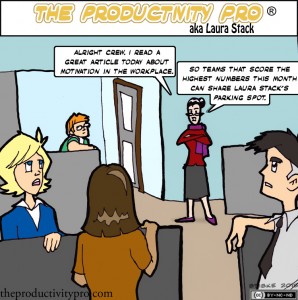“When you want to succeed as bad as you want to breathe, then you’ll be successful.“ – Eric Thomas, American motivational speaker.

One of the eternal quests of the modern business leader is the search for the Holy Grail of worker motivation—as if there’s just one secret, one formula or recipe, that will instantly and permanently push a team’s productivity through the roof. It’s a nice fantasy, but you quickly learn that nothing works for everyone. Fortunately, most people respond well to intrinsic rewards, like pats on the back and public recognition, as well as the king of extrinsic motivation, More Money. But there’s no panacea that invariably turns disengaged grumps into optimistic top performers, while still urging existing performers ever upward.
As it turns out, our basic system of motivation may be flawed, because many employers focus almost exclusively on individuals. According to a recent study by economists Peter Kuhn and Marie-Claire Villeval, competition-based motivational efforts lead many workers, especially men, to hold back information from the team in an effort to win. Women tend to prefer team-based initiatives; but as Kuhn and Villeval point out, this may hold them back in terms of salary and position in competitive environments.
Toward More Effective Motivation
Clearly, individual rewards as motivation can have a negative impact on teamwork. But what about team motivation? With team incentives, no one on the team gets individual rewards; but if the team excels as a whole, everyone wins.(<-Click to Tweet) This still works best if there’s someone to compete against—for example, if sales teams compete for a big prize, like an all-expenses paid vacation. In a company where sales teams regularly land six- or seven-figure contracts, this represents a rather inexpensive way to increase department-wide productivity.
Unfortunately, team motivational efforts have their own negative aspects (with human beings involved, nothing ever comes easy!). Social loafing has been recognized as an anchor dragging down team initiatives since a landmark 1991 study,[1] and it’s exactly what it sounds like. Some team members just skate by on everyone else’s work, not contributing much but still getting the same rewards as those who worked their tails off. This irritates and sometimes infuriates their hard-working teammates, because it’s simply not fair; and once they realize that, they have to ask themselves, why bother to keep working hard? Teachers and college professors have known of this phenomenon for years, because they see it repeatedly in the teams they group their students into. Some educators don’t even bother to assign group projects anymore.
That said, collective rewards can work if the team and its leader actively discourage social loafing. But the team leader can’t keep an eye on everyone all the time, and asking your team members to spy on each other has obvious detrimental effects. Self-policing by the team is a better option. You can also offset the negative aspects of team incentives with additional, individual incentives; in turn, the team incentives may blunt the negative results of individual incentives. But where does this happy medium occur?
New Rule, Old Rule
According to Dr. Brooks Mitchell, there’s very little research concerning the most effective ratio of individual and team incentives to apply. Most leaders use their experience to determine how or if to mix team and individual incentives. Mitchell, based on his own experience, suggests a 75/25 rule (reminiscent of the old 80/20 rule) where leaders and HR apply 75% individual incentives and 25% team incentives to their work groups. This balances the advantages of both, allowing for the stability, sense of ownership, and collaborative benefits of teamwork while awarding high-performers, who might otherwise reject team incentives. Some workers will always shoot for individual accomplishment, and that’s fine as long as they also support the team.
Mitchell’s model seems a good place to start when trying to motivate your team. But realize that the two different categories of incentives, while they can be used in concert, may also work best under different circumstances. You’ll have to tweak your percentages to fit your team, and may have to change your incentive structure altogether if events require. It’s a delicate balance, but necessary to maximize team performance.
© 2015 Laura Stack. Laura Stack, MBA, CSP, CPAE is an award-winning keynote speaker, bestselling author, and noted authority on employee and team productivity. She is the president of The Productivity Pro, Inc., a company dedicated to helping leaders increase workplace performance in high-stress environments. Stack has authored seven books, including her newest work, Doing the Right Things Right: How the Effective Executive Spends Time (Jan. 2016). She is a past president of the National Speakers Association, and in 2015 was inducted into its exclusive Speaker Hall of Fame (with fewer than 175 members worldwide). Stack’s clients include Cisco Systems, Wal-Mart, and Bank of America, and she has been featured on the CBS Early Show and CNN, and in the New York Times. To have Laura Stack speak at your next event, call 303-471-7401 or visit her website.
[1] Williams, Kip, and Karau, Steven. “Social loafing and social compensation: The effects of expectations of coworker performance.” Journal of Personality and Social Psychology 61 (1991): 570-581.



[…] of Motivation: Adding Team Incentives to the Mix https://theproductivitypro.com/blog/2015/11/methods-of-motivation-adding-team-incentives-to-the-mix/ by Laura Stack […]